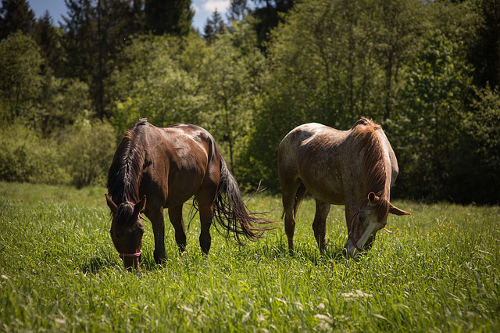What To Do Now About Equine Herpes Virus 1 (EHV-1)
Jun 5th 2018
 Equine Herpes Virus 1 (EHV-1) is a serious condition that carries a lot of scientific details with it. Many of those details are outside the scope of this article (otherwise it would be a very long article). What you will find here, though, is a brass tacks overview of EHV-1, including how it operates and what you can do to prevent an EHV-1 outbreak in your barn.
Equine Herpes Virus 1 (EHV-1) is a serious condition that carries a lot of scientific details with it. Many of those details are outside the scope of this article (otherwise it would be a very long article). What you will find here, though, is a brass tacks overview of EHV-1, including how it operates and what you can do to prevent an EHV-1 outbreak in your barn.
Whenever an outbreak happens, media can sensationalize the issue, making it seem like something that has come out of nowhere. This is not the case with EHV-1. The virus has been around for quite some time, though it does mutate often. This frequent mutation, as with influenza virus in humans, makes it difficult to nail down long-lasting vaccines that prevent the spread of EHV-1.
While EHV-1 can lead to four different types of diseases in your horse, this article is going to place emphasis on two: respiratory and neurologic. Common symptoms of EHV-1 include runny nose, lethargy, spiking high fever, and general malaise. Many horses just get the respiratory version of EHV-1 and are fine after several days, with no future concerns.
In other horses, however—and no one is quite sure why yet—the respiratory version of EHV-1 transitions into the neurologic version. What is known is that the EHV-1 virus works its way into a horse's spinal fluid and causes a viral infection in the brain and spinal fluid. This is known as a myeloencephalopathy. This myeloencephalopathy is what leads to the rapid shift from respiratory to neurologic.
It cannot be stressed enough that the EHV-1 virus is incredibly contagious. There are numerous ways a horse can contract EHV-1. Because EHV-1 spreads through nasal secretion, it can be contracted when a healthy horse touches noses with an infected horse. It can also be contracted through the air. It can even be contracted if the horse is in a barn where a previous horse had EVH-1.
When outbreaks occur, there are four key steps you can take to keep your horse healthy and happy.
1. Stay at Home
This first step is quite simple, still it often seems like a big ask. Just stay home. No horse show is worth subjecting your horse to EHV-1. If you need to interact with your other horse-owning friends, keep it to phone calls or messaging. If you have a group trail ride planned, cancel it. The absolute best way to keep your horse from getting EHV-1 is to keep them home and away from other horses.
2. Vaccinate
Let's be clear, there is not an EHV-1 vaccine that prevents the neurologic version of EHV-1. There are a few, however, that are labeled to prevent the respiratory version. As discussed, since the neurologic form starts as a respiratory form, preventing the respiratory form can help to prevent both the respiratory and neurologic forms. The vaccine that helps prevent the respiratory form of EHV-1 is also known as the "rhino vaccine" and is the one that is included with your horse's normal series of vaccines. Note: rhino vaccines, even in typical conditions, normally have a tremendously short efficacy. That said, if you feel your horse is in a high-risk situation (e.g., been exposed to affected horses and/or barns) it would be wise to consider getting a rhino-only booster.
Two rhino vaccines that are commonly effective against EHV-1 are Rhinomune and Pneumabort-K.
Because Rhinomune vaccine is a modified live vaccine, it should only be given to non-pregnant horses. Something to keep in mind is that, following the vaccination, your horse may develop colicky symptoms. The odds of this are very slight, but it is worth keeping an eye on your horse following the vaccination.
For pregnant mares, Pneumabort-K is safe. It is also fine for non-pregnant mare, geldings, and stallions alike. It is, however, what is known as a "high-reaction" vaccine, which means it will often create a lump in the muscle tissue where the shot is administered.
Remember, the point of this vaccination is to prevent the respiratory form of EHV-1, so you can also prevent the neurologic form that develops from the respiratory form.
3. Immune System Boosters
Zylexis is an immune booster for the respiratory kind of EHV-1. Zylexis, and other immune boosters, work to boost your horse's own immune system to help fortify it against viruses and/or recover from them more quickly. Zylexis is an intramuscular injection that is administered on days zero, two, and nine.
Similar to Zylexis is EqStim. Rather than administration by intramuscular injection, EqStim is administered via an IV.
4. Think
As mentioned above, keep your horse home and keep away any other horses that don't need to be there. Outbreaks, EHV-1 and otherwise, always pass, so be patient and avoid traveling with your horse unless it is absolutely necessary. And, if you are not sure whether you are doing something to putt your horse in a risky situation, it is best to not do that thing.
In Conclusion
It is impossible to stop outbreaks. Being armed with medicines and knowledge before one occurs, however, goes a long way towards keeping your horse healthy and happy.

